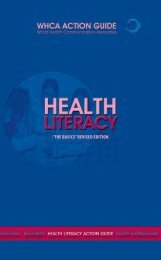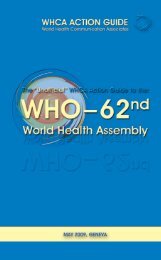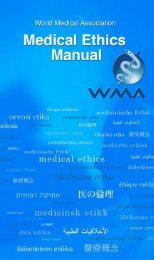Part 1 'the basics' - World Health Communication Associates
Part 1 'the basics' - World Health Communication Associates
Part 1 'the basics' - World Health Communication Associates
You also want an ePaper? Increase the reach of your titles
YUMPU automatically turns print PDFs into web optimized ePapers that Google loves.
type of service provider and the extent to which the call is scripted. They may also<br />
vary depending on characteristics and responses of the individual, and the extent to<br />
which subsequent calls take into account information from other encounters with the<br />
person (IOM 2002).<br />
New communication technologies offer educational opportunities that<br />
help people to be more involved in their health decisions and treatment. These<br />
technologies include web-based learning, audio-visual aids (for example videos,<br />
DVDs, spoken word), interactive games and ‘mobile health’ (M-health). ‘Mobile<br />
health’ is working on capturing the power of short message service (SMS) messaging<br />
to support literacy. One example of this is in India. ‘Baby Centre’ is a service to which<br />
mothers can SMS their due dates to a service centre. They will then receive a set of<br />
texts with their injection dates and scan dates, thereby providing a tailored response<br />
(Ratzan 2009, pers. comm.).<br />
4.1.3 navigating health systems<br />
Many health systems, particularly at institutional and community level, have tried to<br />
make their services more navigable by using case managers and navigators to help<br />
patients. Navigators can be community health workers, lay or professional, paid or<br />
volunteers, but their role is to help patients through the health or social care system.<br />
They can be trained to provide health education, interpret health information and<br />
assist in obtaining access to services (Freeman et al. 1995).<br />
4.1.4 Provider training<br />
Providers should be trained to communicate more effectively to help them care for<br />
patients with limited health literacy. Training should focus on enhancing clinician<br />
communication skills and understanding of cultural sensitivities (Frankel and Stein<br />
2001). Furthermore, the need for improved clinician skills in fostering mutual learning,<br />
partnership-building, collaborative goal-setting and behaviour change with and for<br />
chronic disease patients has been identified (Wagner 2003; youmans and Schillinger<br />
2003). Training works best when it is informed by users with limited health literacy,<br />
who are often under-represented in clinical research (IOM 2004, p277).<br />
22<br />
Section 4: wHat can we do to StrenGtHen HealtH literacy?






